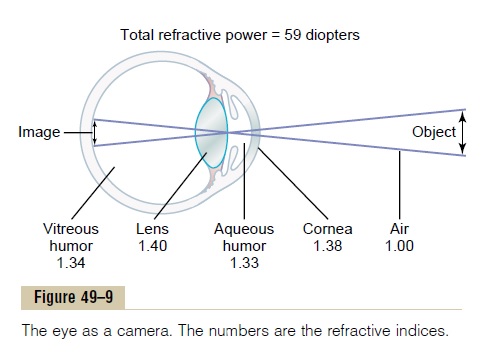Chapter: Medical Physiology: The Eye: I. Optics of Vision
The Eye as a Camera - Optics of the Eye

Optics of the Eye
The Eye as a Camera
The eye, shown in Figure 49–9, is optically equivalent to the usual photographic camera. It has a lens system, a variable aperture system (the pupil), and a retina that corresponds to the film. The lens system of the eye is composed of four refractive interfaces: (1) the inter-face between air and the anterior surface of the cornea, (2) the interface between the posterior surface of the cornea and the aqueous humor, (3) the interface between the aqueous humor and the anterior surface of the lens of the eye, and (4) the interface between the posterior surface of the lens and the vitreous humor. The internal index of air is 1; the cornea, 1.38; the aqueous humor, 1.33; the crystalline lens (on average), 1.40; and the vitreous humor, 1.34.

Reduced Eye. If all the refractive surfaces of the eye arealgebraically added together and then considered to be one single lens, the optics of the normal eye may be simplified and represented schematically as a “reduced eye.” This is useful in simple calculations. In the reduced eye, a single refractive surface is considered to exist, with its central point 17 millimeters in front of the retina and a total refractive power of 59 diopters when the lens is accommodated for distant vision.
About two thirds of the 59 diopters of refractive power of the eye is provided by the anterior surface of the cornea (not by the eye lens). The principal reason for this is that the refractive index of the cornea is markedly different from that of air, while the refrac-tive index of the eye lens is not greatly different from the indices of the aqueous humor and vitreous humor.
The total refractive power of the internal lens of the eye, as it normally lies in the eye surrounded by fluid on each side, is only 20 diopters, about one third the total refractive power of the eye. But the importance of the internal lens is that, in response to nervous signals from the brain, its curvature can be increased markedly to provide “accommodation,”.
Formation of an Image on the Retina. In the same mannerthat a glass lens can focus an image on a sheet of paper, the lens system of the eye can focus an image on the retina. The image is inverted and reversed with respect to the object. However, the mind perceives objects in the upright position despite the upside-down orienta-tion on the retina because the brain is trained to con-sider an inverted image as the normal.
Related Topics